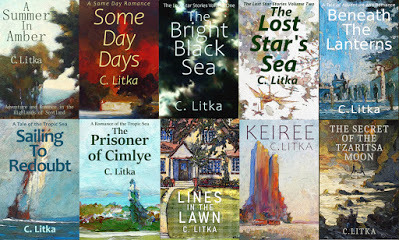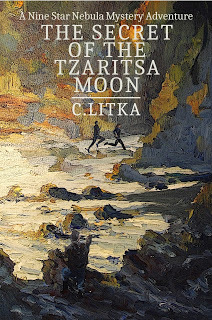FIve and One Half Years in Self Publishing

Time flies, and so, once again, it’s time to report my May 2020 through October 2020 results.
Irelease twonew stories in the last six months. The first was Lines in the Lawn, an illustrated children’s short story via Smashwords only. It was something I had laying around for a decade and I decided to get it out. The second new release was a novella, Keiree. Currently it is a stand alone story, but I hope to build on it, to eventually roll it into a novel.
Sales Numbers
As usual, almost all of the sales are free ebooks sold through Amazon, Smashwords, Apple, B & N, and Google. My books are also available on Kobo but they do not report free sales to Smashwords, plus some are also listed on other sites that offer free books as well.
Book Title / Release Date
1H 2020 Sales
Total Sale To date
A Summer in Amber
23 April 2015
371
7,589
Some Day Days
9 July 2015
163
4,016
The Bright Black Sea
17 Sept 2015
542
13,036
Castaways of the Lost Star
4 Aug 2016
Withdrawn
2,176
The Lost Star’s Sea
13 July 2017
440
6,423
Beneath the Lanterns
13 Sept 2018
253
2,493
Sailing to Redoubt
15 March 2019
221
1,825
Prisoner of Cimlye
2 April 2020
240
485
Lines in the Lawn*
8 June 2020
55
55
Keiree*
18 Sept 2020
174
174
Total Six Month Sales
* New releases.
2,219
38,275
For comparison sake, for the same time period last year I sold 4,590 books, without the last three books on this chart. So last year I sold a little over twice as many books last year as I did this year. Last year, however, was unexpectedly, my best year ever.
For this time period my sales split between Amazon, Google, and Smashwords (including sales on Apple and B & N) works out like this:
Amazon 35%
Smashwords (Apple & B & N) 39%
Google 26%
Last year, 1 Nov 2019 the breakdown was,
Amazon 39%
Smashwords 52%
Google 9%
If we look at sales this past month, October 2020, the split looks like this:
Amazon (15%)
Smashwords (54%)
Google (31%)
The numbers show that my Amazon sales are fading. Smashwords is, more or less holding steady (though half of what it was in 2019), but Google has come through to pick up some of the slack. My goal is to sell at least 300 books a month, as so far I’m clearing that bar, though it takes more books in my catalog to do so.
Back in May, in my 5th annual report, I wrote that I did not expect 2020 to be a banner year. Indeed, I had not expected 2019 to be a banner year either, but it turned out to be one. However, this time around, it’s looking like I’ll be right. The first half hasn’t been terrible, but it is definitely off last year’s pace.
Headwinds
As I see it, there are two things outside of my control that are weighing on my sales. The first is that it seems that Amazon no longer feels the need to match prices. While my older books are still free, my newer books are not. I’ve made the usual efforts to get them to match the free price of the other ebook stores, but even if successful, that only lasts for a couple of weeks before they’re back to full price.
Now, $.99 is a cheap price, and I do sell some at that price, but free sells much better. Unfortunately, Amazon accounts for something like 70% or more of the ebook market, so this new policy bites into my sales.
The second drag on my sales is the way that the ebook market has evolved. Five years ago, ebook advocates were talking about how ebooks would come to dominate the market for books, making paper books extinct. This is clearly not the case now, nor will it be for the foreseeable future. Ebooks have evolvedto dominate some types of genre fiction, like romance, and SFF, whichwere formally served by pulp magazines, mass market paperbacks, and libraries. And in those categories to a very special type of reader, the avid readers. These readers what and expect books to reliably deliver what they expect them to deliver, like the fans of Big Macs, which are expected to taste the same no matter where you consume it. Ebooks are, in short, have become the fast food of books.
This is, of course, alegitimate market. And nice work, if you can get it. But it takes more than books to get in it. These days it takes thousands of dollars of advertising, and a large,established readership that an indie-publisher can bet thosethousands of dollars of advertising on. Pay to play, as they say. Just as with Etsy, where the local handmade goods market evolved into handmade goods from the sweatshops of China, the author self-publisher has evolved in a similar way. Today, the best selling books are produced bythe entrepreneur publisher who either works 16 hours a day to write, manage advertising on a daily basis, hire editors, cover artists, and manage the business in general, or to someone who hire others to do all these tasks, including writing, in order toproduce a dependable stream of, good-enough Big Mac type booksto feed their customers in the Kindle Unlimited all-you-can-read buffet.
I have no desire to be on that treadmill.Better them than me, is pretty much my attitude. But the downside of this evolution is that unless a writer is producing and spending big money promoting their Big Mac books, the market is for ebooks is deceptively shallow these days. I’m lucky to have gotten into self publishing when I did, as I doubt that I’d be able to give away 38,000 books in five and half years on a zero advertising budget if I was starting today. My initial experiment was to see if I could use free books to build an audience and a presence large enough that I could some day, if I cared to, charge money for my books. I have to say that, given the way the market has evolved, the answer seems to be no. Fortunately for me, it was an academic experiment, so I can’t, and am not complaining.
Looking Ahead

I will be releasingmy next novel, a cozy SF mystery/adventure, The Secret of the Tzaritsa Moon, either this month or in early December. I’m planning on starting a second cozy SF mystery/adventure with the same characters this month, with a target release date oflate February or early March. I may decide to release Lines in the Lawn on Amazon. And I have another small project of short-short stories and cartoons dealing with robots that I might work on at some point as well in the next six months. I’ve got nothing better to do these days than write, so as long as I have ideas, I’ll be writing, if not selling a ton of books.



